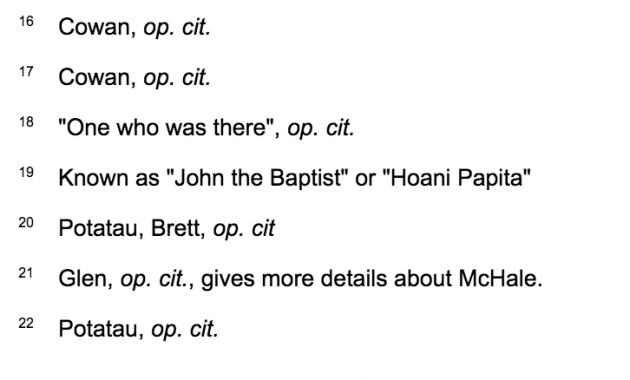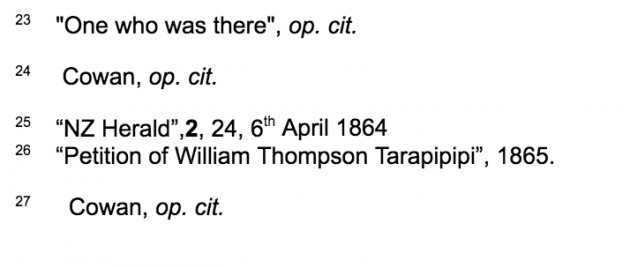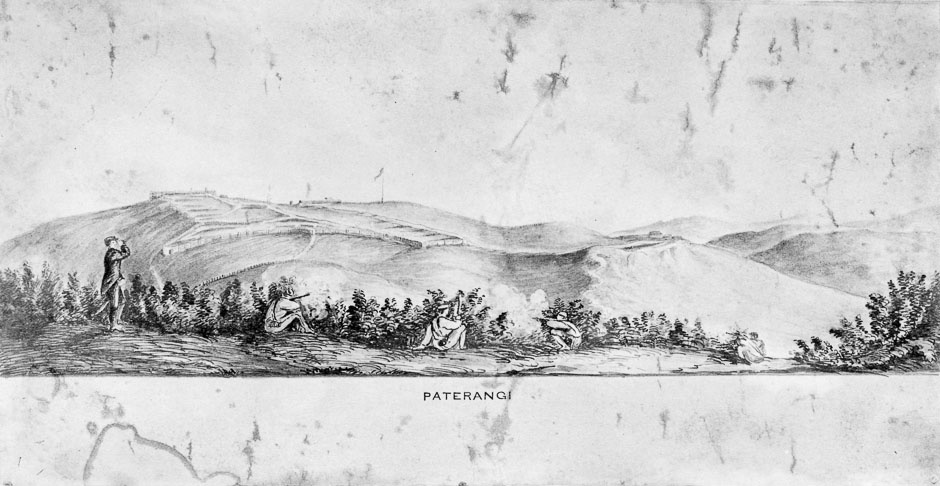Bruce Moon
We Have Just one True History: Part One
And so we come to the Rangiaowhia affray (10) about which probably more flagrant lies have been touted than any other event in our history.[…]
“Cameron, with commendable humanitarianism (our emphasis), wanted to avoid a set piece military confrontation because the likely casualties such a battle would engender would be severe on both sides.” (11) […]
The recent rediscovery of consistent accounts of two participants, a member of Cameron’s force and a Maori named Potatau who was a lad at the centre of the action (12) give us now a more accurate picture of the true story than even celebrated historian James Cowan (13) was able to achieve. It is of critical importance that the truth so revealed be told.
So here is the true story:
On the night of 20th February at 11 o’clock, the mixed force of colonial cavalry, regular infantry, artillery and Forest Rangers paraded. Horses feet were muffled and their gear wrapped in cloth. Passing successfully close by the rebel defences in the darkness, the cavalry reached the village soon after dawn. With many Maori civilians, men and women, running away, Captain Wilson commanding the advance guard called to the women in Maori to sit down to avoid the risk of being shot. “They obeyed, and we passed them; then they got up and ran on.” (14)
Soon the troops were everywhere in the village. There was some skirmishing as Maoris began firing from their huts at the cavalrymen. “One or two of [the] snipers were women.” (15) “The Forest Rangers found the Roman Catholic church … crammed with armed Maoris, who showed a white flag and were not pressed further.” (16) “The English church, too, was filled with Maoris, and some shots came from the windows.” (17)

“It did not take long for the cavalry to clear the enemy out of Rangiaohia [sic], our infantry being far in the rear. Having accomplished our work, we had turned about and were taking prisoners as we came along, when Captain Wilson’s attention was drawn to a whare, near which a struggle was going on between Corporal Little, of ours, and a huge Maori. … I heard some days afterwards that the big Maori, whom I mentioned before as having been taken prisoner, had said that his life was saved by a man who wore a silver band round his cap, meaning Captain Wilson. ” (18)
Meantime, the boy, Potatau, leaving the house where he had spent the night, saw some troopers passing nearby. He takes up the story:
“I at once ran to my father’s house. I had not been long there when my grandfather [chief Hoani] (19) came to the same house. … so that he might die with us – [Chief] Ihaia, Rawiri and his son. At this time myself and my mother went outside the house, and sat at the door of the house. I heard my father say to my grandfather: ‘Let us lay down our guns and give ourselves up as prisoners.’ … My grandfather would not agree. At this time the soldiers came to us, and asked my mother in Maori: ‘Are there any Maoris in the house?’ She replied: ‘No, there are no Maoris in the house.’ My father at once said: ‘Yes, there are Maoris here.’ The European who spoke Maori came to the door of the house, and caught hold of my father, and handed him over to the soldiers.” (20)
It is pretty evident that the “big Maori” who was captured was Potatau’s father, Captain Wilson who had taken him turning him over to the corporal.
At this point, Captain Wilson ordered Sergeant McHale, the sole Australian volunteer in the cavalry, to enter the hut and take the occupants, prisoner. (21)
Potatau again:
“The European went inside of the house. My grandfather shot him and killed him. Some of the others dragged the body in the house. At this time my mother and self arose and went through the soldiers and between the troopers. They did not interfere with us, but allowed us to pass. We went to the house of Thomas Power, who had a Maori woman to wife. After we left we heard the soldiers firing. … [After] the firing had ceased[, w]e at once left the place and ran off to the bush, and made for Rangitoto.” (22)
“Captain Wilson called out ‘What are you shooting the Maoris for?’ and jumping from his horse was into the hut in a moment. The door was so low he had to stoop to get inside. The place was full of smoke, and as Captain Wilson entered he found under him McHale’s body, his feet towards the door, and face down. The captain could not see anyone else for the darkness and smoke,
consequently he soon backed out, calling out that McHale had been shot, which the men no sooner heard than with their carbines they commenced to riddle the house, which was built of slabs. The firing soon brought together the whole of the cavalry, and after a while some of the 65th and Forest Rangers, also the general and staff, came up. It was after General Cameron’s arrival that Colonel Nixon was shot from the door of the whare. Then, as the Maoris did not surrender when challenged for the second time, the infantry fired the house. I saw one Maori walk out of the blazing hut, his blanket singed on his back. Poor fellow! he fell within ten paces of the door whence he and his compatriots had so wantonly shot our colonel and many other good men. There was nothing now to prevent us from recovering McHale’s body, but its condition was such that we could hardly distinguish it from the Maoris around him.” (23)

Of the one who walked out of the blazing hut, Cowan says: “A tall old man, clothed in a white blanket [twisted to a white flag in some modern tales] … emerged from the doorway of the burning house. His upstretched arms showed that he had no weapon. ‘Spare him, spare him!” shouted the nearest officers. But next moment there was a thunder of shots. … the old hero … swayed slowly and fell dead to the ground. The episode enraged the chivalrous officers who had entreated quarter for him.”
The irony of all this is that the “old hero” must have been Potatau’s grandfather who had fired the shot which killed McHale and started the whole fracas. Almost the last survivor, he had realized that the game was up and walked out to meet his fate. Had he heeded his son’s advice at the start to give themselves up, none of it would have happened. As it was, nearly all the casualties at Rangiaowhia occurred there. Two more men came forth from the whare and were shot dead while firing at the troops then the burning building collapsed. Besides the charred body of McHale, seven bodies were found in the ruins. One source says that two of them were daughters of Kereopa Te Rau who barbarously swallowed the eyes of murdered missionary Volkner.
In the final incident “at the Catholic church some of Hoani Papita’s men made a short stand. Twenty or thirty of them rushed into the church and fired through the windows, and it was thought at first that they intended standing a siege there, but they discovered that the weatherboards were not bullet-proof. The rangers and some Regulars attacked, and the church-walls were soon perforated with bullets. At last the defenders dashed out through the door on the northern side, and fled into the swamps.” (24) “The churches remained intact, “two officers of the 50th Regiment live in the Catholic Church. The beautifully stained glass windows of the English church are entire.” (25) . Even prominent rebel leader Wiremu Tamihana admitted this, saying: “There was only one house burnt; that was the house where the Maoris died. I went there and saw it.” (26)

Five of Cameron’s men, one being Colonel Nixon, were killed at the ill-fated whare or died later of wounds. Ten Maoris died there including the chiefs Ihaia and Hoani who made the fateful decision not to surrender at the start as his son had advised him. Just two Maoris were killed in the entire remainder of the action. “About thirty prisoners, some wounded, were taken.” (27) Cameron’s own account says “About twelve natives were killed and twelve taken prisoner. I have detained 21 women and children who were found in the village”. (28) A little arithmetic verifies that these figures are consistent.
Searching the whares afterwards, the troops found substantial quantities of arms. So much for O’Malley’s ”place of refuge for women, children and the elderly”. A white flag was raised at the property of Thomas Power and his wife, Rahapa, née Te Hauata, where many of the women and children were sheltering unharmed and it was left strictly alone.
“After the skirmish at Rangiaohia, the troops returned and camped at Otawhao, the Rev. John Morgan’s missionary station (now known as Te Awamutu), …. The slain were buried; the Maori wounded and prisoners kindly cared for, having tents pitched for their use.” (29)

So there it is, pretty much the whole story, now unrecognizable in the false accounts of women and children being burned alive in the church, too readily believed by our part-Maori revisionists and their white fellow-travellers. It was not long before such stories began to circulate.
To be continued…

